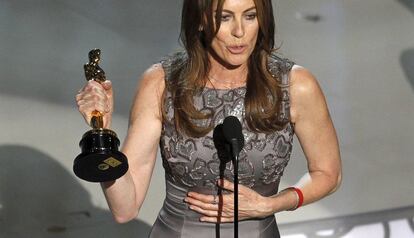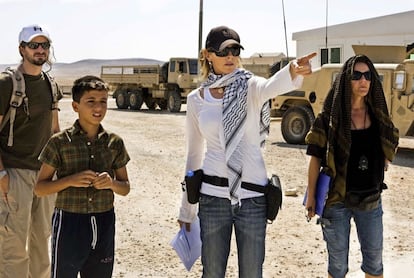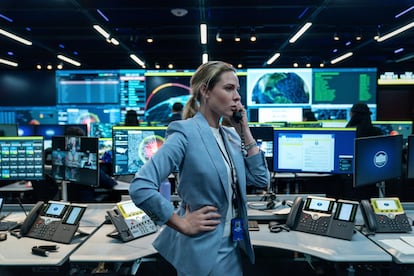At little Kathryn Bigelow’s school, and in many others in the United States in the sixties, an alarm sometimes sounded. Not the one at recess or coming home. A different one, which the filmmaker still remembers. Anyone, including children, knew the protocol: stand under the desks and wait. They could only leave when the teachers authorized them, a sign that the umpteenth atomic drill had passed. Until the next one. “That’s how it was immediately perceived. During and after the Cold War there were conversations, agreements, and then everything stopped. Disarmament treaties were signed, but they have also disappeared. The threat has only escalated and, even so, we don’t talk about it,” lamented the director before a group of international journalists a month ago, at the Venice festival. From these reflections emerged A house full of dynamiteand thriller Nuclear which premieres this Friday, October 10, in Spanish theaters, before moving to Netflix in two weeks. At 71 years old, Bigelow no longer hides under his desk. On the contrary, he has stood over him, to warn everyone. Now, it is she herself who is sounding the alarm.
“It is a silent threat, as if we lived under the shadow of peace. For decades we have not debated these issues. I wanted to open Pandora’s box and look inside. I hope the film encourages a conversation, knowledge is power,” the creator said in Venice. Hence, he has filmed another protocol: the one that is unleashed when an atomic missile flies over the United States on its way to destroy the city of Chicago. There are 18 minutes left before millions of lives disappear, along with the illusion of an untouchable superpower. Officials, analysts and politicians, from the Pentagon to the National Security Agency, are racing against the clock to study the origin, options, measures. The chain of command escalates until everything is reduced to a single human being, who has the final word and exclusive access to the red button: the president.
Long before sending shivers down the spine of audiences, the film troubled its own creators. “While we were filming, it became more and more current,” he emphasizes. The script, by Noah Oppenheim, comes from talks and research with government teams and sources very knowledgeable about the authentic process. So you see what would presumably happen. True is, for example, the probability cited in the feature film of stopping a possible nuclear attack in flight: around 61%. “Like hitting one bullet with another,” one character sums it up. The screenwriter discovered that the members of the crisis cabinet have much more preparation for this than their top boss. “Noah and I spoke with a person whose job it would be to accompany the president in an emergency like this and he said that they had never tried it, that they never had time. The highest levels of intelligence wanted to collaborate; numbers, digits and percentages that we show fall within the scope of total honesty,” he points out.
After all, the director has been using her camera as a magnifying glass on the US Administration and its dirty laundry for years. In 2008 he even co-financed In a hostile land, in order to bring forward the story of three bomb defusers in the midst of the US invasion of Iraq. The darkest nightin 2012, reconstructed the White House’s long and questionable hunt for Osama Bin Laden, responsible for the 9/11 attacks. Although the criticism this time was also for Bigelow: the film showed torture of prisoners who, finally, released decisive information. There were those who considered it a whitewashing of the CIA, even those who compared the director to Leni Riefenstahl, the famous author of Nazi propaganda films. Although Bigelow’s next film, Detroitcleared up any doubts about its intentions: it narrated the riots in the city in 1967, which led to the death of three black protesters and the incrimination of three white police officers for homicide.
Since then, eight years have passed without Bigelow films. Probably, moviegoers have missed it much more than the power of the United States. And even less so now, when it returns with A house full of dynamite. “I am interested in films that take us to places we have never been, or give us information that we don’t know,” the director emphasizes. He says he is moved by the questions that are spinning in his head. And he hopes that the public also leaves his works with questions, instead of chewed certainties. “Offering solutions would take pressure and responsibility off of us.”

She herself soon began to question the system. She was born in San Carlos (California), the only daughter of a librarian and a factory manager who actually wanted to be a painter. At first, Bigelow tried to bring his father’s dream to fruition. She has often been described as a “shy” girl, who saw “a way out” in art. She went to study in San Francisco and New York, where she learned under the guidance of Susan Sontag and became friends with Philip Glass and Laurie Anderson. There he found another lesson, which he related to The Guardian: “Art has a political responsibility, it is not designed to be decorative.” While protesting in the streets against the Vietnam War, the young woman made canvases and conceptual works. Until he realized that painting was “somewhat elitist,” while cinema crossed social classes. Another renowned professor, director Milos Forman, saw in Bigelow’s unfinished short film the spark to offer him a scholarship at Columbia University. Another brilliant insight from the filmmaker One Flew Over the Cuckoo’s Nest.
Bigelow’s own filmography, which began in 1981 with The Loveless, It led to a few rebellions. It spent decades being empirical proof to dismantle the stupidity that only men can film thrillers and manage large productions. First, came the vampire western The night travelers y They call him Bodhi (Point Break), cult film about a robbery between boards and waves. Rebecca Ferguson, star of A house full of dynamite and present at the talk in Venice, he imagined with a laugh the frustration in the US Government: “Couldn’t you continue making movies about surfers?” Instead he filmed the war drama K-19: The Widowmaker, about a submarine precisely with a nuclear arsenal. And, in 2010, she became the first woman in history to win the Oscar for best director, for In hostile land. Award, also, for an impossible filming, in a Jordan that was burning at 54 degrees. And defeating, in the process, her ex-husband, James Cameron, candidate for Avatar. Hard to break more glass ceilings in one fell swoop.

“Kathryn works with authenticity,” Ferguson stressed. And with a little notebook, apparently, that he carries everywhere to jot down notes and ideas. One of the first for A house full of dynamite was for it to happen in real time, as the director explained: “We had to work within a deadline of 18 minutes and, at the same time, be totally rigorous. It could be a great short film. But there was a lot of information and it was wonderful to break it down and look at it from different points.” So the identical scene is repeated, but always with new elements and perspectives, from a common soldier to the president himself. The cold blood, the panic, the calculations, the anxiety. There is not a second to waste. And, even so, everyone looks for a moment to warn home. In addition to protocol, there is humanity. The same one that had the idea of moving to A house full of dynamite. In Venice, Bigelow expressed his astonishment: “How can a system capable of annihilating civilization be a defense measure? It’s like a riddle that makes absolutely no sense.” It is up to the viewer to try to respond. Or run and hide under a desk.

